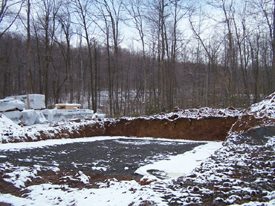Many Katahdin Cedar Log Home customers choose sites that are not part of an established development. Rural parcels and undeveloped land have requirements that should be assessed early in the process, as infrastructure costs can become a substantial part of your budget. When you review your site with your real estate broker, your Katahdin Dealer or Representative and your contractor, you’ll want to identify these key elements.
 Cutting and clearing wooded sites. Walk the land and identify the building envelope and the path of your driveway or road. Take note of significant established trees within your building site – preserving these elders will provide existing landscaping for your new home. You may need to reconsider roadways based on the requirements for culverts, ground stability, drainage and other factors.
Cutting and clearing wooded sites. Walk the land and identify the building envelope and the path of your driveway or road. Take note of significant established trees within your building site – preserving these elders will provide existing landscaping for your new home. You may need to reconsider roadways based on the requirements for culverts, ground stability, drainage and other factors.
Road or driveway construction. Because your Katahdin Cedar Log Home will arrive to your building site on a semi-tractor trailer, you’ll need to configure your road and driveway to accommodate these oversized vehicles, including turnarounds. If such turnarounds or access is not practical, you’ll need to plan for staging areas, where the large semi can be offloaded onto smaller flatbed trucks. Make sure you have a solid base under your roadways. Also give special consideration to the distance your site is from sources of materials, such as gravel, sand, concrete or stone. If your site is located a long distance from these materials locations, you’ll pay extra for transporting the materials to your site.
Excavation, blasting and fill. Each site has its own special characteristics, some of which will not be discovered until ground is broken. If your area is prone to hidden hazards like rock ledges, friable soil or other factors, you’ll want to have a little extra budget set aside in case you need to dynamite rock, or add fill to your site. Less than optimum site characteristics can often be remedied by a skilled excavator, some fill and a culvert or two. An average home can take about 1-2 days to excavate under ideal conditions, depending on the size and complexity of your home.
Utilities. If you are not part of a subdivision or development that has electrical, cable and other utilities available on the lot, you’ll need to plan to get power, telephone and cable to your home. Your local Katahdin Dealer or contractor will know the best way to construct for utility service, either via poles or underground. You’ll want to make sure that all utilities are coordinated so that the cables can be strung or laid in trenches at the same time.
Official Address. This is also a very good time to begin work on identifying your “official” or emergency 911 address. If you are located in a rural area you may need to name your private road, alert your local post office or emergency agency to receive appropriate numbering and signage. Your new official address may be required for your mortgage, and will be necessary to release your home for shipment from Oakfield to the building site.
Click here to download a printable version of this page OR click here to download the entire “Guide to Building Your Log Home”.
